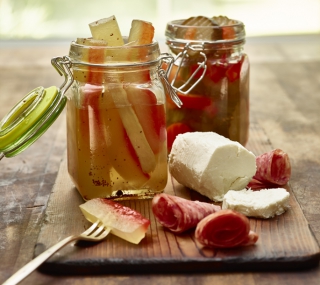
Food Quiz Tests Chefs Knowledge of Fruit
30 March 2017What fruit is 100 percent edible, cost effective, full of electrolytes and a great flavor counter point to salty? And the answer is ….
By Lisa Parrish, GMC Editor
Culinary arts instructors know about food. Show off your culinary knowledge and take this quiz:
Identify the fruit that is:
- 100 percent useable with no waste
- 92 percent water
- Budget-friendly at 14 cents per serving, according to a recent survey
- Packed with nutrients such as citrulline, antioxidants, vitamins A and C, lycopene and potassium
- A great post-workout option because it is chockfull of electrolytes
- Sweet flavor pairs well with salty options such as cheese
- The first cookbook published in the United States in 1796, “American Cookery” by Amelia Simmons, contains a recipe for this pickled food
Your answer is: _________________________________________
If you said watermelon you get an A plus for food knowledge – congratulations.
Chef instructors may be surprised to find watermelon is cost effective as it has no waste. The rind is edible and can be a vegetable substitute in dishes such as a stir fry or kimchi. By leaving the slightest hint of red flesh on the rind, chefs have included this color pop when pickling watermelon rind for charcuterie boards or as a salad topper.
Red-fleshed watermelons average 15 to 20 pounds with a 67 percent flesh yield on average. They are available in seeded and seedless varieties. Due to hybridization or breeding advances, the red flesh is becoming more red and crisp than in the past. Other varieties include mini watermelons with thinner rinds that are available in one to seven pounds and yellow- and orange-fleshed watermelons, which are generally sweater than traditional watermelons. Watermelons can be sourced year-round.
Megan McKenna, National Watermelon Promotion Board director of foodservice and marketing, says that watermelon’s sweet flavor easily pairs with a variety of cheeses. “Cheese and watermelon pair together well due to the sweet and salty, savory flavor contrast. Feta is the most commonly paired cheese, although we have also seen goat, blue and ricotta salada more and more. Additionally, we see watermelon with mozzarella in a spin on caprese salad,” she said. “The moist, crunch of watermelon can complement the texture of cheeses, especially soft cheeses.”
According to McKenna, Datassential MenuTrends Research found that cheese menued with watermelon in appetizers, entrees and sides grew 54 percent from 2010 to 2014. Specifically, feta and watermelon grew 23 percent during that same period.
Watermelon is a versatile fruit in the kitchen with tremendous nutritional benefits as well. Elizabeth Somer, registered dietitian, frequent contributor to NBC’s Today show and author of 11 books, extols the benefits of a diet rich in colorful fruits and vegetables. She says of watermelon, “It is rich in water, fat- and cholesterol-free, and loaded with vitamins, minerals, and phytonutrients.” She continues, “Watermelon is 92 percent water and has less than 50 calories per cup. It’s a good source of vitamins, such as vitamins A and C, and minerals, such as potassium. Watermelon also is a chin-dribbling delightful snack to satisfy a sweet tooth, while you pack in the nutrients without many calories!”
As chef educators train students in core concerns such as healthy food options, sustainability and the excessive costs of food waste, introducing students to watermelon – more than the sliced picnic treat – can add to their repertoire of food knowledge.
Culinary arts instructors can go to the National Watermelon Promotion Board’s web site for recipes, cutting techniques, selection and storage information as well as carving videos.
Photos courtesy of the National Watermelon Promotion Board.
